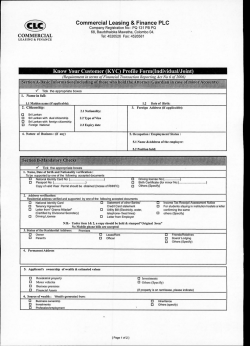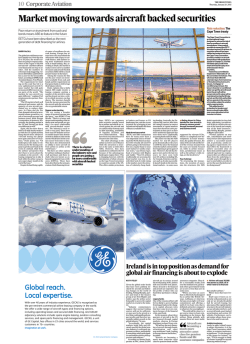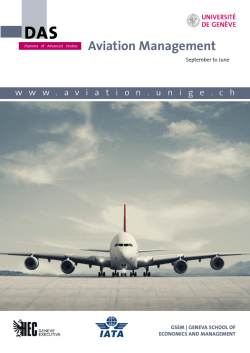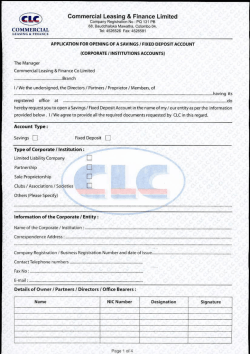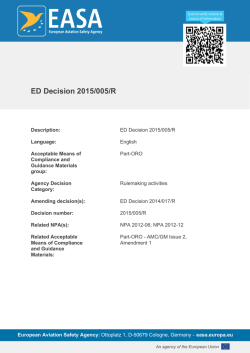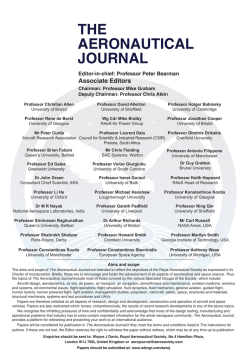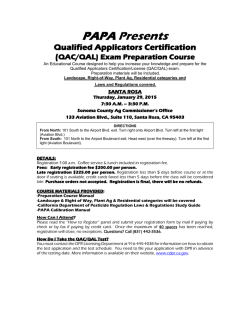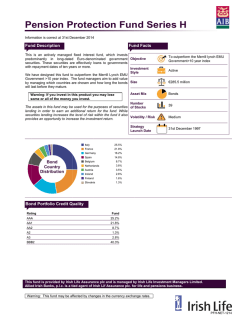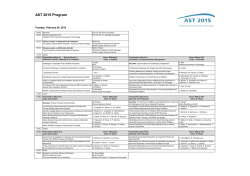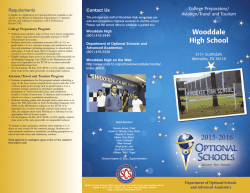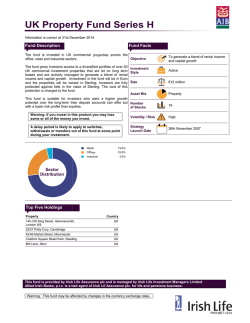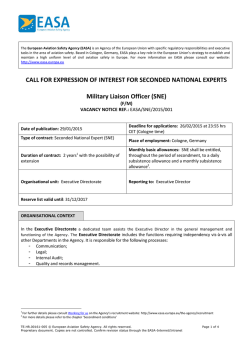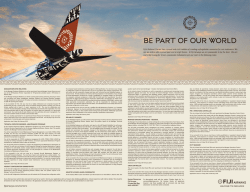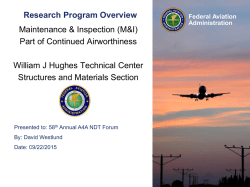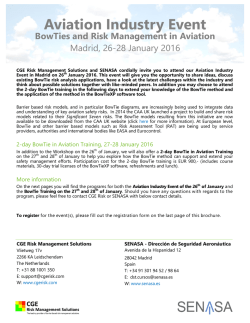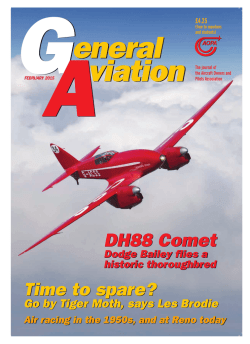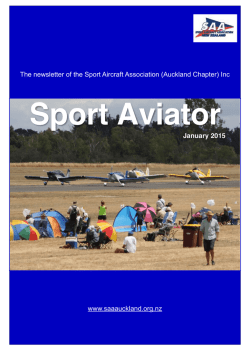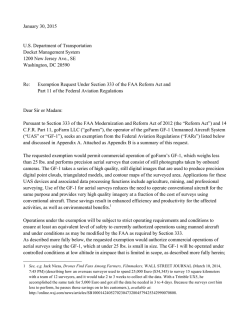
Ireland flies high in aviation leasing and finance sector
8 Corporate Aviation THE IRISH TIMES Thursday, January 29 , 2015 ASpecialReport Ireland flies high in aviation leasing and finance sector On the up: The secrets of Ireland’s success Irish-led lessor AerCap now the world’s second largest aircraft leasing company Aviation leasing and finance contributes over ¤4 billion directly to Ireland’s GDP CLAIRE O’MAHONY The past 12 months have been significant for the aviation leasing and finance sector in Ireland, with Irish-based firms closing a number of billon-dollar merger deals. The acquisition of International Lease Finance Corporation (ILFC) by Irish-led lessor AerCap now makes it the second largest aircraft leasing company. This deal represented yet another coup for the industry that has garnered a reputation for being a global leader in aircraft leasing and finance. Nine of the world’s 10 largest leasing companies are located in Ireland. Of the estimated 20,000 commercial jet aircraft flying globally, 8,000 of those are leased and more than half are managed from this country. “The aviation sector as a whole is of major importance to Ireland,” says Eamonn Brennan, chief executive of the Irish Aviation Authority (IAA). He says the sector contributes just over ¤4 billion directly to our GDP, nearly half of which comes directly from aviation. “Around ¤1.3 billion comes through the supply chain and another ¤0.9 billion comes from associated spending by people employed in aviation,” he says, adding that the industry supports 26,000 jobs directly and a further 16,000 in the supply chain. There is no indication that leasing will become less attractive to airlines anytime soon. For stronger airlines it diversifies their aircraft funding and leaves the risk on the residual value of aircraft with the lessors who are expert in managing this. For other airlines it is one of the only sources of financing available to them. Ronan Doyle, partner at PwC, observes that the flexibility of leasing is key for airlines. “If you own an aircraft you have got it for its life unless you sell it on.Whereas if you lease the aircraft you’ve got the ability to give it back,” says Doyle. He says the big win for the airline is that it gets to pass on the risk on the residual value of the assets to the lessor. “The downside is that if you only have the aircraft for eight years, at the end of eight years the lease rate may have gone way up. That’s why airlines don’t lease all of their aircraft because then they will be open to the vagaries of the market. Normally the rough rule of thumb is about 60 per cent of the aircraft should be owned, 40 per cent should be leased.” CanIrelandsustainposition? The question for the future is whether Ireland can sustain its position as a world leader in corporate aviation, particularly with other jurisdictions looking at the success the country has had and seeking to replicate it. The signs are that the outlook is good. Doyle points out that with bond yields zero or close to zero in some jurisdictions, this is an attractive asset class with a decent yield in a reasonably stable business which is operating globally. 2015 promises to be another ■ The future looks bright for the aviation leasing and finance industry in Ireland very active year, according to KPMG’s head of aviation finance, Tom Woods. A KPMG industry survey conducted last year and updated this year showed that Irish lessors had more than $66 billion worth of orders for new aircraft with manufacturers. “When you add to that the number of new aircraft that lessors will buy from airlines and lease back to them and the aircraft that will be bought and sold in the secondary market, the volume of trade is staggering,” says Woods. He adds that it is estimated that the annual financing requirement for new aircraft alone each year for the next 10 years is between $110 billion$120 billion and Irish compa- nies will be involved in much of this. “2015 will see a lot of aircraft purchases and leases. The securitisation market should continue to be strong with the capital markets open on both the debt and equity side,” he says. Ireland, therefore, seems very well placed to continue to provide a leading role in the evolution of the industry. New technologies, specifically in terms of fuel efficiency are among of the challenges that lie ahead. Based on KPMG’s survey, Woods feels the future looks bright. “The Government has been very supportive in maintaining our competitiveness – the most recent example being the changes to our domestic insolvency laws for investors in aviation assets. Favourablefuelprices “This largely mirrors the protections in the US Chapter Thisyear’s17thGlobal AirfinanceConferenceheldin DublinonJanuary20-22nd haditshighesteverattendance of1,815delegatesfromallover theworld. Thesuccessoftheeventand thefactitishostedinDublin everyyearisanindicationof howfartheleasingandfinance sectorhascomeinthis country. “Anaircraftlessorcancome intoDublinandinaspaceof aboutahalfanhour,canvisita lawyer,anaccountant,a serviceproviderwhohas decadesofexperiencedoing this,andthereprobablyisn’t anywhereelsewhichisableto demonstratethat,”saysPwC partnerRonanDoyle. OtherkeyfactorsinIreland’s successinthisareaincludeits geographicallocationandthe factthatitisEnglishspeaking andintheeurozone. Thelowcorporationtaxand theflexibilityoftheaccounting andfinancialreportingframeworksisanothersellingpoint, asisthetaxnetworktreatythat Irelandhas. “Irelandhasnorthof70tax treatieswhichhavebeen signed,whichallow leasing fromIrelandintoanother jurisdictionataveryattractive rateofwithholdingtax,”says Doyle. “There’snoother geographyornoother competitorjurisdictionthat hasataxtreatynetworkthat getsclosetothatintermsof flexibility.” NollaigMurphy,partnerat MaplesandCalder,agreesthat thissuccesslookssetto continue. “Throughinstitutional, corporateandgovernmental supportforthesector,itisa coreIrishserviceindustrywith acomplementaryregulatory, taxandinsolvencyregime,”he says. “Withthecurrentand expectedriseinfinancing ofthesectorthroughthe capitalmarkets,Irelandis alsouniquelyplacedintheEU toservicethisasbothan aviationandSPVissuer jurisdictionofchoicein Europe.” TheIAA’sEamonnBrennan believesthatsuccessbreeds successandthathasplayeda keyroleinthegrowthofthe industry. “Therearethreatsfrom othercountriestotake marketshare,suchas SingaporeortheNetherlands, butIbelievethatIrelandIncis notbeingcomplacentandthat stepsarebeingtakento safeguardandgrowthis sector,”hesays. 11.10 code and Alternative A of the Cape Town Convention. It is awaiting a ministerial order before coming into force and when it comes through it should make Ireland more attractive as a centre for aircraft financing as well as aircraft leasing,” he says. Donna Ager, partner at Maples and Calder, agrees that 2015 looks set to be another good year for aviation. “With Boeing and Airbus producing yet more aircraft there is plenty of space for everyone and opportunity for investors to make money and the airlines to benefit from attractive lease rates. “Whilst the underlying cyclical nature of the industry continues, at the moment it appears that both investors and airlines, assisted by the favourable fuel prices, are both riding on the crest of a wave with no downturn occurring in the near future,” she says. Developing intellectual capital in the aircraft industry JOHN CRADDEN Ireland is well-known for punching above its weight in air transport industry terms thanks to the presence here of virtually every major player in the global aircraft finance and leasing sector, but a new award ceremony last year helped to highlight examples of excellence right across the industry for the first time. The inaugural Aviation Industry Awards, which took place last July, attracted 130 entries from 70 different firms for no less than 16 separate award categories. Awardslongoverdue Eamonn Brennan, chief executive of the Irish Aviation Authority (IAA) and sole sponsor of the awards, said the decision to establish the award ceremony was long overdue. “There was no industry recognition of the many outstanding businesses and individuals who excel in their respective fields. “These awards are not seeking to highlight one specific field, they are designed to recognise the collective achievement of the entire Irish aviation industry,” he says. It’s a sector that “makes a significant contribution to the country’s economy”, employing 26,000 people and contributing ¤4.1 billion to national GDP. “The success and immense growth of the aviation sector in Ireland would not be possible without the outstanding work carried out by individuals and businesses across the entire island, from airlines to airports, pilots, engineers, finance and leasing companies, support services, researchers, training institutions, safety and security professionals, and, of course, the general aviation enthusiasts,” says Brennan. 16awardcategoriesthisyear Among the 16 award categories of this year’s awards, which are due to take place in May (entries close in March), are for the best in the fields of airports, air operators, leasing, customer service, education, training, innovation, R&D, environment and safety. As head of the body responsible for the air traffic management of Irish airspace and for the safety and security regulation of the Irish civil aviation industry, Brennan says it was good to see last year how many ■ Dómhnal Slattery, from Avolon, receiving the Aviation Leasing Achievement Award from Eamonn Brennan, chief executive of the Irish Aviation Authority, at the Aviation Industry Awards 2014 (top), and Kell Ryan, brother of the late Dr Tony Ryan, receiving the Outstanding Contribution to Irish Aviation Award from Leo Varadkar. PHOTOGRAPHS: ROBBIE REYNOLDS were committed to safety. “It was really encouraging to see how many individuals and businesses were going the extra mile to make the industry ‘‘ Safety is the bedrock of our industry and our general safety oversight ranking is amongst the best in the world safer and more efficient. “Safety is the bedrock of our industry and our general safety ranking is amongst the best in the world.” Among the highlights of last year’s ceremony was the posthumous award to Ryanair founder Dr Tony Ryan for “Outstanding Contribution to Irish Aviation”, which was accepted by his brother Kell Ryan. As well as founding Ryanair, the award also recognised Dr Ryan’s efforts in building the air finance and leasing sector here. “The sector is set to continue to grow and this is something we should all be immensely proud of,” says Brennan. “Our air finance and leasing sector is thriving. Ryanair is going from strength to strength. Our air traffic management system is the most advanced in Europe, the Irish aircraft register has increased by 88 per cent since 2001 and domestic traffic at the three State airports [Dublin, Shannon and Cork] was up 6.5 per cent last year.”
© Copyright 2026
